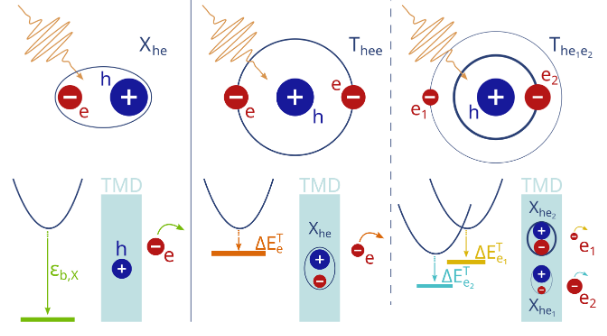Main Content
Preprints
Inhalt ausklappen Inhalt einklappen 224. G. Meneghini, M. Löwe, R. Perea-Causin, J. P. Bange, W. Bennecke, M. Reutzel, S. Mathias, E. Malic, "ARPES signatures of trions in van der Waals materials", arXiv: 2511.11448

Angle-resolved photoemission spectroscopy (ARPES) has recently emerged as a direct probe of excitonic correlations in two-dimensional semiconductors, resolving their dispersion and dynamics in energy-momentum space, including dark exciton states inaccessible to optical techniques. However, the ARPES fingerprint of charged excitons (trions), which plays a key role in all doped and gated 2D material systems, has remained unknown so far. We present a first theoretical analysis of trion signatures in monolayer transition-metal dichalcogenides, highlighting how the additional charge carrier modifies the spectral position and shape relative to neutral excitons in ARPES spectra. Interestingly, we further predict that mass-imbalanced trions yield a characteristic double-peak structure, clearly separated in energy and line shape from neutral excitons. The predicted temperature dependence of these features offers guidance for experimental investigations aimed at identifying trionic states, thereby establishing a framework for ARPES studies of many-body Coulomb complexes in doped two-dimensional semiconductors.
arXiv: 2511.11448Inhalt ausklappen Inhalt einklappen 223. S. Shradha, R. Rosati, H. Lamsaadi, J. Picker, I. Paradisanos, Md T. Hossain, L. Krelle, L. F. Oswald, N. Engel, D. I. Markina, K. Watanabe, T. Taniguchi, P. K. Sahoo, L. Lombez, X. Marie, P. Renucci, V. Paillard, J.-M. Poumirol, A. Turchanin, E. Malic, B. Urbaszek, "2D Excitonics with Atomically Thin Lateral Heterostructures", arXiv: 2510.21422

Semiconducting transition metal dichalcogenides (TMDs), such as MoSe2 and WSe2, exhibit unique optical and electronic properties. Vertical stacking of layers of one or more TMDs, to create heterostructures, has expanded the fields of moiré physics and twistronics. Bottom-up fabrication techniques, such as chemical vapor deposition, have advanced the creation of heterostructures beyond what was possible with mechanical exfoliation and stacking. These techniques now enable the fabrication of lateral heterostructures, where two or more monolayers are covalently bonded in the plane of their atoms. At their atomically sharp interfaces, lateral heterostructures exhibit additional phenomena, such as the formation of charge-transfer excitons, in which the electron and hole reside on opposite sides of the interface. Due to the energy landscape created by differences in the band structures of the constituent materials, unique effects such as unidirectional exciton transport and excitonic lensing can be observed in lateral heterostructures. This review outlines recent progress in exciton dynamics and spectroscopy of TMD-based lateral heterostructures and offers an outlook on future developments in excitonics in this promising system.
arXiv: 2510.21422Inhalt ausklappen Inhalt einklappen 222. P. Werner, W. Bennecke, J. P. Bange, G. Meneghini, D. Schmitt, M. Merboldt, A. M. Seiler, A. AlMutairi, K. Watanabe, T. Taniguchi, G. S. Matthijs Jansen, J. Liu, D. Steil, S. Hofmann, R. Thomas Weitz, E. Malic, S. Mathias, M. Reutzel "The role of non-equilibrium populations in dark exciton formation", arXiv: 2505.06074

In two-dimensional transition metal dichalcogenide structures, the optical excitation of a bright exciton may be followed by the formation of a plethora of lower energy dark states. In these formation and relaxation processes between different exciton species, non-equilibrium exciton and phonon populations play a dominant role, but remain so far largely unexplored as most states are inaccessible by regular spectroscopies. Here, on the example of homobilayer 2H-MoS, we realize direct access to the full exciton relaxation cascade from experiment and theory. By measuring the energy- and in-plane momentum-resolved photoemission spectral function, we reveal a distinct fingerprint for dark excitons in a non-equilibrium excitonic occupation distribution. In excellent agreement with microscopic many-particle calculations, we quantify the timescales for the formation of a non-equilibrium dark excitonic occupation and its subsequent thermalization to 85~fs and 150~fs, respectively. Our results provide a previously inaccessible view of the complete exciton relaxation cascade, which is of paramount importance for the future characterization of non-equilibrium excitonic phases and the efficient design of optoelectronic devices based on two-dimensional materials.
arXiv: 2505.06074